Staying fit, maintaining a healthy weight, and eating a proper diet is essential for a high quality of life. Monetizing the services that help people attain these goals is highly profitable, considering the growing demand for fitness and diet health in recent years worldwide.
To see how developing such an app can help gain commercial success, check one of our past projects for Mammoth Hunters. Using our experience in this niche, we’ve prepared a step-by-step guide on how to make a fitness app and get maximum profit by applying various monetization approaches.
Fitness App Market Overview
Fitness today is more than a way of getting a strong and beautiful body. It has become an excellent way to fight stress during a pandemic and increase activity to balance the 'sitting at home' lifestyle. When gyms had to start refusing on-site training, many people began using fitness apps for tracking activity and exercising at home. Fitness apps are currently on the rise, according to numerous researches conducted in the past two years.
Grand View Research shows that the global market size for fitness apps will stably grow for the next 7 years. In 2020, the market value was $4.4 billion, and with a CAGR of 21.6%, it should reach 15.6 billion by 2028.
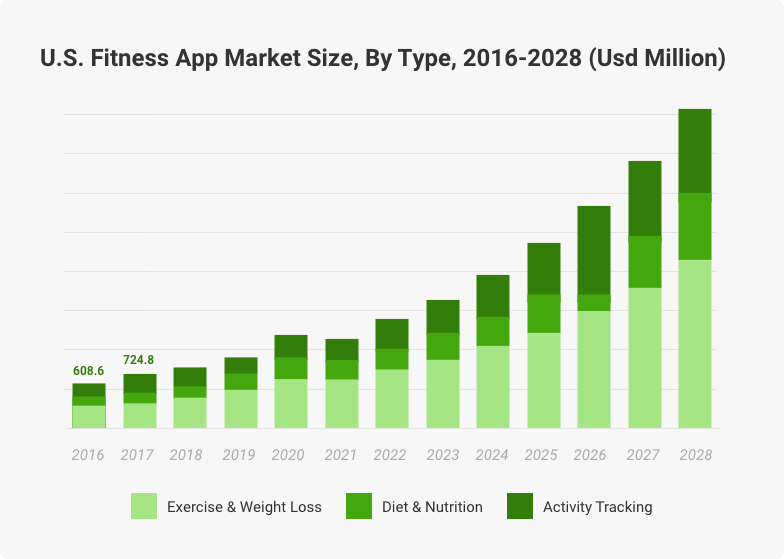
Global Fitness App Market Size 2016-2028
The coronavirus has become a powerful trigger for the growing popularity of health and fitness applications too. According to a SensorTower survey, global app downloads grew by 47% during the first half of 2020.
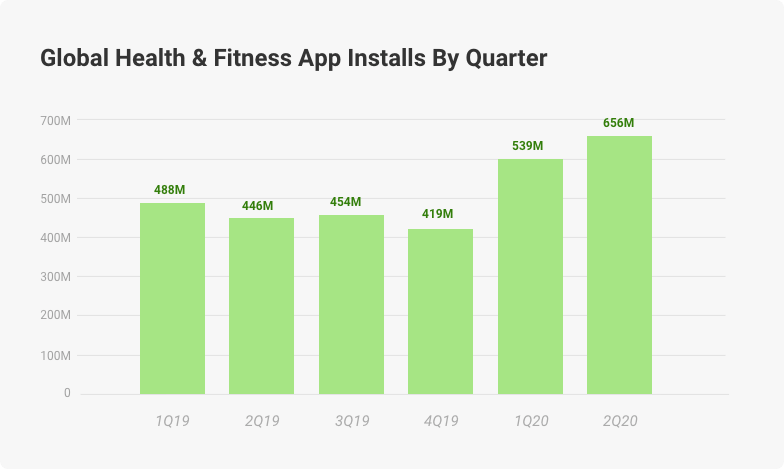
Global Health & Fitness App Installs 2019-2020
The online training trend is going to grow. The number of Daily Active Users (DAUs) is constantly rising. Studios and gyms are increasing their presence online, offering their customers to train at home.
The key market drivers include:
- Growing digitalization
- Rising interest in a healthy lifestyle and keeping fit
- The growth of smartphone and mobile device usage
- Increasing rates of obesity globally
- Pandemic and lockdown
The statistics by geography helps to understand what markets are reasonable to enter when you create a fitness app of your own. It makes sense to create specific language versions for countries that bring the most users. As per fitness and health application, the top 10 countries that share 76% of the market include:
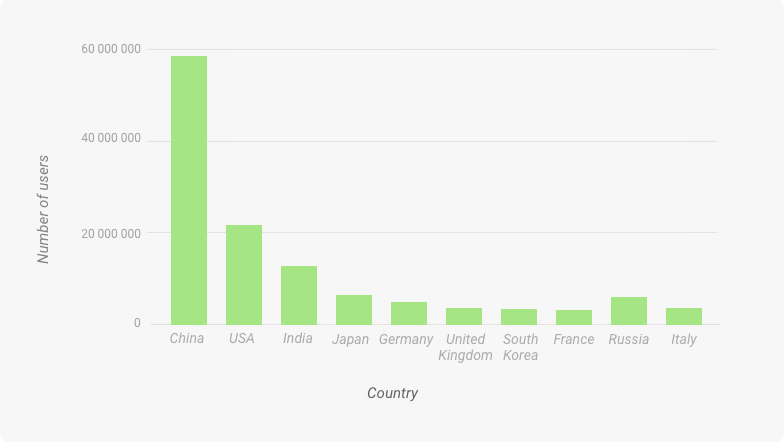
Number of Fitness and Diet Apps Users By Country
It is the right time for new fitness app development because the statistics show that the market will grow steadily. More people are interested in training at home, increasing their activity, and controlling their calories and diet. They require more high-quality applications, and the market is still favorable for launching new products.
Choose the Right Fitness App by Type
Modern applications for healthy lifestyle fans combine various options. In practice, lots of products on the market offer hybrid functionalities. Here is a classic division for the three major app categories.
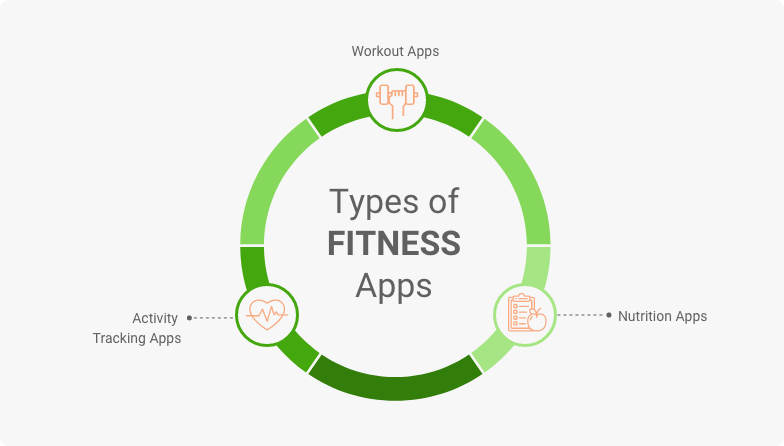
Group 1. Workout Apps
About 3/4 of all fitness software are workout apps that allow users to exercise independently using preset training plans, workout programs, and video sessions. They often provide exercises for attaining specific fitness goals and let users count burned calories. If you decide to build a fitness application of this type, keep in mind that it is the most competitive category yet the most popular among users.
Advanced solutions of this kind are integrated with fitness wearables. They can customize workout routines based on your health data and current state (heartbeat, pressure, etc.).
Traditionally, workout apps offer one or a few services from this list:
- Exercise guides, videos, personalized recommendations for workouts, and nutrition plans according to the user's goals (Fitbit Coach, Shred, Freeletics).
- On-demand personal trainers for individual activity (Fitmo, Handstand).
- Workouts that focus on one specific discipline or combine a few styles in one single workout program. Fitness with yoga elements is extremely popular, as are gym activities combined with stretching (Yoga Wake Up).
Some applications serve only for planning training and tracking progress without providing workout videos or samples (My Workout Plan, Gym Workout Planner). These apps are popular among people experienced in fitness, who only need professional guidance to build a systematic workout plan.
Group 2. Activity Tracking Apps
These applications are mainly used to track running, relying heavily on GPS to track the routes, distance, and speed. Usually, they are integrated with various wearables like fitness wristbands. Data tracked from them can be used to analyze the user’s parameters and activity.
Besides recording running routes and statistics, activity trackers allow users to share their achievements in social networks. It helps to engage friends, monitor each other’s progress, and stay active in specialized communities. Check Runcoach, Pacer, and Human to see all these features in action.
Besides running, you can build a fitness app to track cycling, gym workouts, and yoga sessions, which users also want to control. Like running trackers, cycling apps allow recording rides, planning routes, tracking the traffic in the chosen directions, etc. (Strava, Komoot). Yoga trackers usually help follow the training plan by counting the number and type of completed sessions, setting goals, and tracking the progress (Track Yoga, Asana Rebel). Gym applications improve training experience using data from wearables, providing comprehensive timers and exercise counters (Fit Notes, Gym Workout Tracker).
Some activity trackers offer multiple modes to track various activities (Runkeeper).
Group 3. Nutrition Apps
Nutrition applications help users to normalize their weight by following various recommendations and diet programs. There are two main types:
- Apps that help lose or gain weight: they feature a calorie counter, a weight tracker, dietary plans, healthy recipes, shopping lists, etc. They help develop correct food habits and plan a balanced diet to correct weight without detriment to a user’s health (8fit, My Plate Calorie Counter).
- Apps to build muscle: these apps help users gain weight by offering targeted workout plans combined with a diet focused on growing muscles (MyFitnessPal, Dr.Muscle).
These are the typical solutions offered today. The most significant benefit of custom fitness application development is that you can combine features from various categories to deliver a unique solution to the market. By offering exceptional value to potential customers, you can fill your own niche among competitors.
Outsource your fitness app creation to the TOP mobile development experts.
Book A CallMust-Have Features for a Fitness App MVP
Depending on the app type and your business goals, you can choose the essential features to develop in your fitness app MVP.
An MVP is a Minimum Viable Product that contains basic functionalities with which an app can be launched to market. Releasing an MVP helps receive user feedback to evaluate if the business idea is cost-effective and is worth further development. It helps to optimize the fitness app development cost and avoid extra losses in case of failure.
Moreover, you can add new features according to real users' feedback after analyzing their activity and demands. Let’s see what features are a must-have for a fitness app MVP.
1. User Account & Login
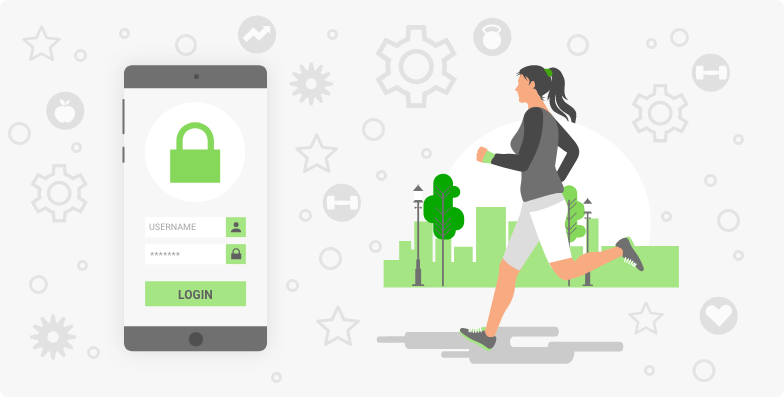
User profile and authorization is the first feature that every application needs. Users want an app to remember their activities, track progress and store personal details. Also, user account and login are required for proper administration when there are multiple access levels to app content, different subscription types, etc.
It would be reasonable to provide multiple registration and login options, including standard login/password, registration via social network accounts, and email. If you plan to offer paid services and content, make sure to integrate your app with third-party APIs for storing billing information securely.
2. Workouts
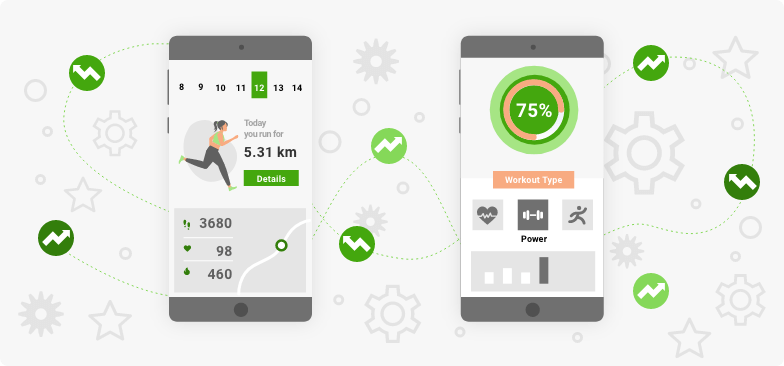
This is the basis of all fitness apps. And here, you have complete freedom to choose how to present workouts to a user. It can be an entire workout session in video format with a specified number of repetitions and sets.
It can also be a workout composer that helps to collect necessary activities based on the user goals. Or it can be a mix of standard sets of basic exercises and customizable workouts for more advanced loads. Some gyms offer live stream videos through their apps to create a ‘gym-like’ experience for users during the lockdown.
3. Geolocation
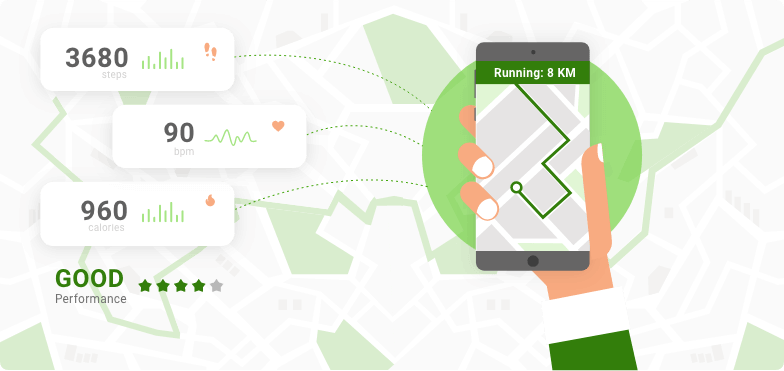
If your app supports activities that imply creating or recording routes or counting distance, make sure it supports geolocation. It is vital for running, cycling, walking, hiking, skiing, and many other sports. Exchanging the geodata with the smartphone's GPS sensor allows the app to track the user's moves and speed and check if the user follows the chosen route correctly. It can record how long the training session took, what the weather is outside if it is suitable for training, etc.
Geolocation might not be necessary for nutrition applications, while other types of fitness apps need it on board.
4. Goal Setting

When a user downloads a fitness app, in most cases, they have a specific goal they want to achieve by active training and a healthy diet. A goal-setting feature is excellent for both user and app performance.
It allows providing users with content maximally relevant to their needs and helps achieve the desired results. Setting goals and seeing the progress towards them motivates users for further activity.
5. Calorie Counter
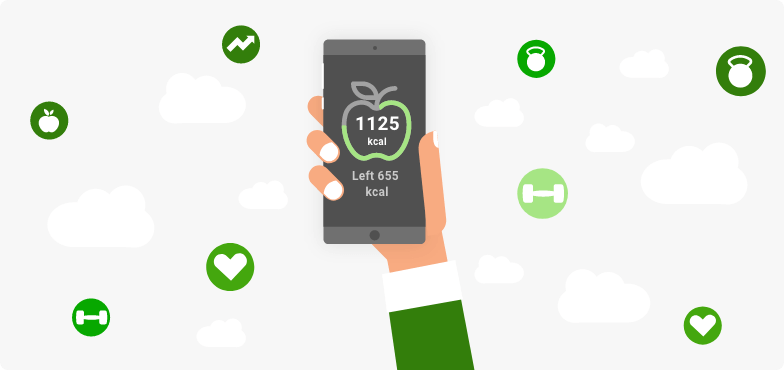
Calorie counting helps users control the calorie intake and consumption to regulate diet and training intensity. This feature is helpful for all kinds of fitness apps, including workout apps, activity trackers, and nutrition services.
For example, MyFitnessPal helps record food intake, featuring a library of more than 6 million products, and allows for tracking the energy value and macronutrient balance for every meal. It also helps track how many calories a user burned during workouts and different activities during the day.
6. Meal Plans
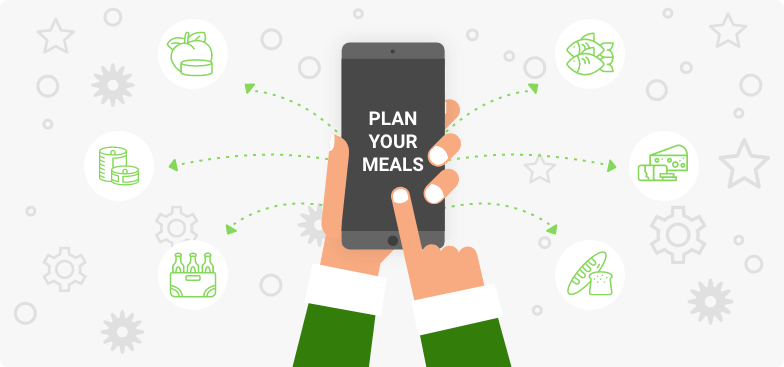
If you are going to launch a nutrition app, meal plans are a must-have feature that will help users follow a balanced diet according to their goals and personal food excesses. Even if you are going to create a fitness application for training, combining workouts with a healthy diet is something many users want to do within one single app. That is why it makes sense to include meal plans in an MVP version.
If you want to go further, think about providing shopping lists alongside diet plans. With meals for daily or weekly plans, a user will get a list of all products to buy at the supermarket for cooking the required dishes.
7. Notifications & Reminders
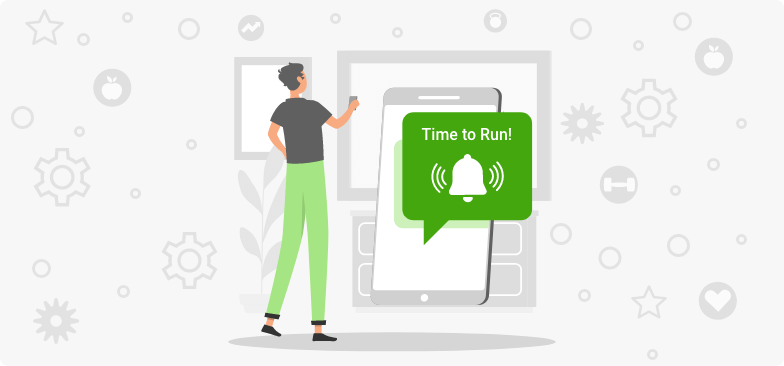
People are often busy and can forget when it’s time to exercise. Ensure you develop a notification system to inform users about all critical updates to their workout plans and remind them about the required actions to help them achieve their goals.
Notifications are essential while training. Timer alarms, moving to the next exercise, repetition counters — all these give a better user experience and lets you use the app without constantly looking at your smartphone screen. Of course, notifications should be customizable so that users can adjust the system for their personal preferences.
8. In-App Payments
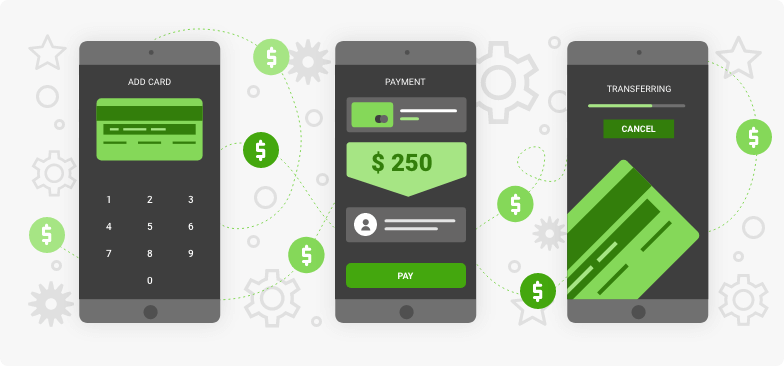
Users should purchase premium content, subscriptions, and other paid services directly in the app. Payments must be as simple as possible. Integrate multiple payment gateways for users to choose from (Apple Pay, GPay, Credit Card, PayPal, etc.).
While all these features are highly essential for a fitness app, you can start with only some of them for your MVP. It highly depends on the app type and specificity of services you’re going to provide. For example, you can develop only account/login, workouts, goal settings, and in-app payments, which can be enough for a start. When choosing basic features, rely upon your budget and desired time to market.
Advanced Features
After releasing your MVP, you can better understand what’s missing in your app and what users would like to see in a full-fledged version. Your team of fitness app developers can work on further improvements to meet the customers’ demands. There are endless capabilities for extending the app features. Here are some ideas that are currently popular trends in the industry:
- Educational content: people who use fitness apps want to know how to stay healthy and fit. To keep them engaged and improve their results, provide access to various educational content to succeed. These can be small tips or complete guides on building a healthy lifestyle, developing personal workout programs, etc.
- Social media features: people are highly motivated to move further when sharing their achievements with friends and other people. Integrate your app with popular social networks like Instagram, Facebook, Twitter to create shareable content like personal records, accomplishments, workouts, etc.
- Wearable connectivity: a mobile app for fitness that involves physical training would benefit from wearable connectivity to track the user’s condition during workout sessions or record distances. One more practical option is sending notifications through wearable devices that are more comfortable for users.
- Tracking activity: most users want to see the consequence of the exercises they should do and track their progress while working out. You can use smartphone and wearable sensors to collect various quality indicators to show the actual effect of exercising and track the progress from session to session.
- Extended device connectivity: in addition to wearables, it makes sense to synchronize the app with other devices like a TV to watch workout videos on a big screen.
- Gamification: it is a powerful motivation tool that increases the user's engagement and loyalty. Develop a system of rewards, badges, contests to stimulate users to continue training. You can give bonuses for completed workouts, frequent training, certain distances passed, etc.
- Virtual reality: merging VR games with working out can work well for users who get bored with regular training and would like to exercise while playing. This niche is relatively new. It is good to offer VR as a nice add-on to entertain users who want such an experience.
- User-generated content: let users post their own workouts or diet recipes and share their results and reviews to develop an active community and increase user engagement. It may require additional administration tools. However, it works great when users can share their own success stories, help each other, and discuss common topics inside an app.
Choosing the Tech Stack
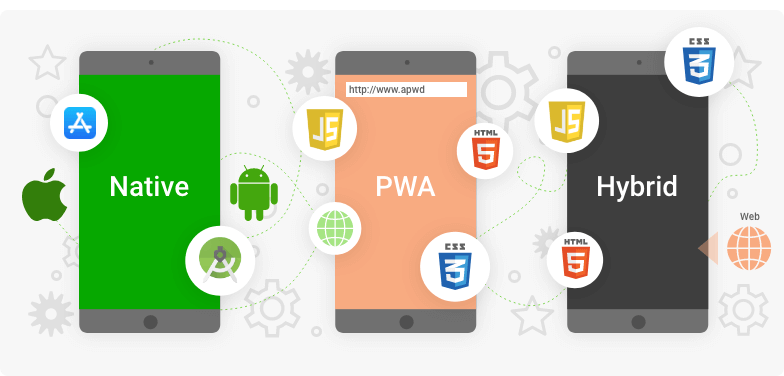
There are a few technical approaches to make a fitness app:
- Native app development that gives full access to using all platform-specific hardware. It implies developing separate app versions for iOS and Android.
- Cross-platformdevelopmentimplies using React Native or Flutter frameworks, which provide the same codebase to compile a version for Android and iOS. It gives faster time-to-market yet has limitations in hardware-specific features.
- Progressive web app (PWA): it is a native-like-app cross-platform web application. You can use this technology to adapt the existing web app to mobile when there is no need to interfere with any external hardware.
- No-code mobile application builders: you can use some of the existing no-code app builders like Appy Pie. However, keep in mind, they are hardly customizable and often cannot provide all desired features.
The choice of technology will affect the time and cost of developing a fitness app. It may impose certain limitations on the capabilities of the future product. The only option with limitless technical potential is native app development. Suppose you plan to create an application with rich functionality. In that case, interaction with wearables and other hardware, and a highly dynamic user interface (common for most fitness apps), we strongly recommend going for custom native mobile development.
Not sure what tech stack is best for your next fitness application? Consult KeyUA software engineers.
Contact UsPick The Best Monetization Strategy
Applications that offer fitness services can bring money in several ways. Depending on how you decide to monetize your app, there will be specific differences in fitness application development. You need to implement technical capabilities for running ads, collecting payments for premium content, etc. Here is a short overview of the monetization approaches you can follow.

These are the Main 4 Ways To Monetize Fitness Apps
1. Paid Apps
The application offers monthly-paid subscription plans. Paying $5 - $50 (or even higher) per month, a user gets access to training programs, diet plans, and other services. As a rule, paid apps do not bother users with any built-in ads and have a free trial period to test all the features.
2. Ad-based Apps
This kind of application gives access to training and other content only after watching ads. Usually, there are many ad formats like videos, image banners, audio ads, text links. For each ad view or click to a link, an app owner gets paid, which forms their profit. Some clients pay the app owner for a certain amount of advertising. Additionally, users are offered an ad-free subscription if they do not want to see ads while using the application. Paid plans generate additional profit while giving users a comfortable ad-free experience.
3. In-App Purchases
Some product owners choose to offer their fitness applications for free and earn money on providing in-app purchases. The most popular products to offer are premium training videos from professional coaches, sports goods, personalized nutrition plans, healthy foods, supplements, and many others.
4. Free Promotional Apps
This type of app is entirely free of charge yet geared towards promoting some branded products. For example, Nike Training Club is a free training service that redirects users to the Nike store to buy various sportswear and accessories. Top brands often release such apps to support their primary business.
Note that you can combine several monetization methods in one application.
Creating a Fitness App In 5 Steps
The actual development is only one step in a great app’s path from an idea to a released product. Here is a complete step-by-step guide of the entire process.
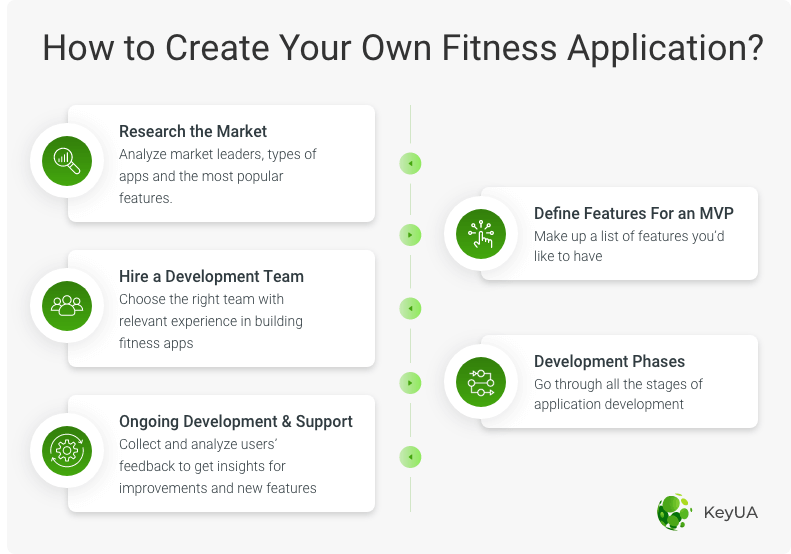
How to build a fitness application in few simple steps
Step 1. Research the Market
Before you create your own workout app for Android and iOS, analyze today’s market leaders, existing types of apps, and the most popular features. It is helpful to check users' reviews to see each solution's pros and cons first-hand and test some of the applications yourself. Also, define your target audience to focus on its specific needs during the development.
Step 2. Define Features For an MVP
Make up a list of all features you’d like your future app to have and check the ones which you would like to see in the first version. These are vital functionalities that you’d like to enter the market with.
Step 3. Hire a Development Team
If software development is not the primary direction of your business, it would be better to outsource the app development to professionals. Choose among outsourcing teams with relevant experience in building fitness applications and deep expertise in the latest mobile development technologies.
Step 4. Development Phases
Now you have everything to start creating your fitness application. The development process consists of a few phases:
- Analysis, planning, and documentation: pass your ideas and requirements to your development team. They will analyze and document the project’s specs and plan the implementation process within the agreed budget and timeframe.
- UI/UX Design: designers create user flows and design graphics for the app’s user interface and create wireframes for future app screens.
- Development: at this stage, developers create the required software architecture and implement all planned features.
- Testing and Deployment: after the development is done, it’s time to ensure there are no bugs before the public launch. After passing through thorough automatic and manual testing, you can release the app to the market.
Step 5. Ongoing Development & Support
After the public launch, you will collect and analyze real users' feedback to get insights for further improvements and new features. Ongoing development helps an application stay competitive for the long run, providing important updates to cover users’ pain points and extend app capabilities with up-to-date options.
Fitness App Development Cost
If you had a chance to outline your needs for the future application’s look-and-feel and required features, then you have a ground for building a budget for its development. It is better to rely on the estimation given by the development company you’ve hired with their technical expertise to analyze all ins and outs of the future project.
Keep in mind that the development price highly depends on where you hire an outsourcing team. For instance, the rates for mobile app developers in the USA are $110/h on average. Talents from Western Europe charge about $80/h, and developers from Eastern Europe work at $50/h. If cost optimization is what you are looking for, it makes sense to consider hiring an outsourcing partner from Ukraine or other Eastern European countries. In this case, assuming an average hourly rate for development is $50/h, we can estimate the fitness app project cost.
| Project Stage | Basic app version | Medium app version | Complex app version |
| What's Included | The simplest features | Custom design, additional features | Complex design, advanced features, heavy support |
| Technical Documentation | $1,000 | $2,000 | $3,000 |
| UI/UX design | $2,000 | $3,000 | $6,000 |
| Front-end development | $18,000 | $21,000 | $24,000 |
| Back-end development | $10,000 | $20,000 | $25,000 |
| Project Management | $4,000 | $8,000 | $16,000 |
| Quality Assurance | $3,000 | $9,000 | $18,000 |
| TOTAL cost: | $38,000 | $63,000 | $92,000 |
| Time: | 3-6 months | 9+ months | 1+ year |
These are rough figures to give you an idea about the budget scale depending on the project complexity. If you need exact figures, please address our experts with your project specs.
Takeaways
A fitness application can become a powerful booster for your business growth. This niche is currently on a high and stable rise. Understanding your market and clear goal-setting may help to get your investments paid off successfully. One more vital success factor is the proper implementation of your app idea.
KeyUA is ready to become your development partner to handle the entire project, from planning to post-launch maintenance. If your in-house team requires additional hands, we’re ready to assist on any development stage. It’s time to start a new era of fitness app experience!
Have an exciting fitness app idea? Let KeyUA bring it to life.
Get In Touch







 Unit 1505 124 City Road, London, United Kingdom, EC1V 2NX
Unit 1505 124 City Road, London, United Kingdom, EC1V 2NX

Comments
Leave a comment